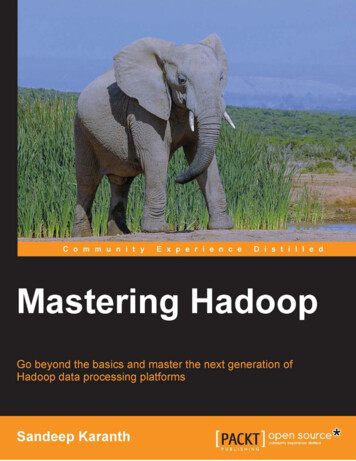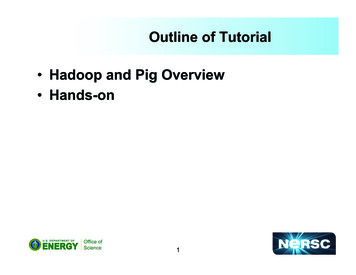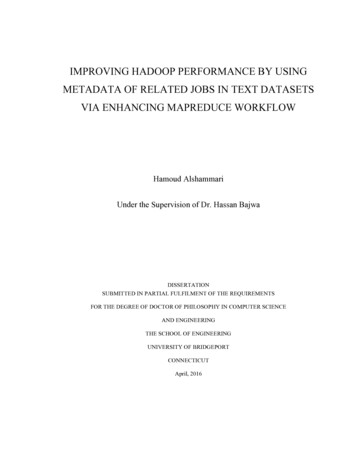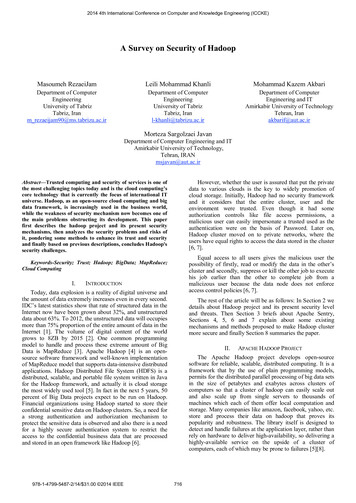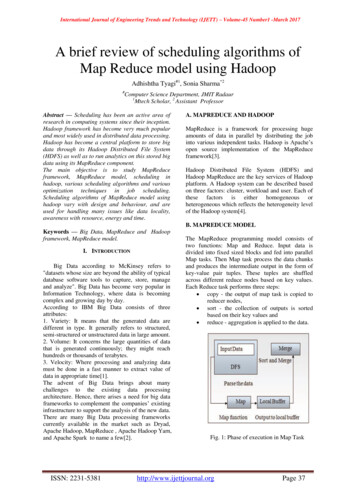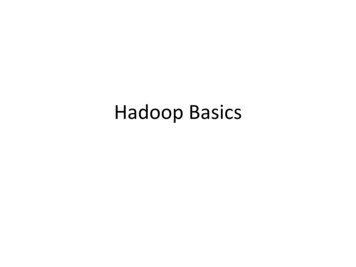
Transcription
Hadoop Basics
A brief history on Hadoop 2003 - Google launches project Nutch to handle billions of searches andindexing millions of web pages. Oct 2003 - Google releases papers with GFS (Google File System) Dec 2004 - Google releases papers with MapReduce 2005 - Nutch used GFS and MapReduce to perform operations 2006 - Yahoo! created Hadoop based on GFS and MapReduce (with DougCutting and team) 2007 - Yahoo started using Hadoop on a 1000 node cluster Jan 2008 - Apache took over Hadoop Jul 2008 - Tested a 4000 node cluster with Hadoop successfully 2009 - Hadoop successfully sorted a petabyte of data in less than 17 hoursto handle billions of searches and indexing millions of web pages. Dec 2011 - Hadoop releases version 1.0 Aug 2013 - Version 2.0.6 is available
Hadoop Ecosystem
The two major components of Hadoop– Hadoop Distributed File System (HDFS)– MapReduce Framework
HDFS HDFS is a filesystem designed for storing verylarge files running on clusters of commodityhardware.- Very large file: some hadoop clusters storespetabytes of data.- Commodity hardware: Hadoop doesn’trequire expensive, highly reliable harware torun on. It is designed to run on clusters ofcommodity hardware.
Blocks- Files in HDFS are broken into block-sizedchunks. Each chunk is stored in anindependent unit.- By default, the size of each block is 64 MB.
- Some benefits of splitting files into blocks.-- a file can be larger than any single disk in thenetwork.-- Blocks fit well with replication for providingfault tolerance and availability. To insure againstcorrupted blocks and disk/machine failure, eachblock is replicated to a small number of physicallyseparate machines.
Namenodes-- The namenode manages the filesystem namespace.-- It maintains the filesystem tree and the metadatafor all the files and directories.-- It also contains the information on the locations ofblocks for a given file. Datanodes- datanodes: stores blocks of files. They report back tothe namenodes periodically
MapReduce Programming Model –Mappers and Reducers In MapReduce, the programmer defines a mapper anda reducer with the following signatures: Implicit between the map and reduce phases is shuffle,sort, and group-by operation on intermediate keys. Output key-value pairs from each reducer are writtenpersistently back onto the distributed file system.
MapReduce Schematic
Word Count- Schematic InBook1Book2Book3Book rd3-Book4n7n8n9n10n11n12Computation:n13 (n1 n1 n7 n8)n14 (n3 n4 n9 n10)n15 (n5 n6 n11 n12)ShuffleKeyReducersfreqOutkey ok4Word1 n13Word2 n14n5n6Word3 n15n11n12
WordCount Example Given the following file that contains four documents#input file1Algorithm design with MapReduce2MapReduce Algorithm3MapReduce Algorithm Implementation4Hadoop Implementation of Hadoop We would like to count the frequency of each uniqueword in this file.
Two blocks of the input file#iblock 11 Algorithm design with MapReduce2 MapReduce AlgorithmComputing node 1: Invoke mapfunction on each key value pair#iblock 21 MapReduce Algorithm implementattion2 Hadoop implmentation of MapReduceComputing node 2: Invoke mapfunction on each key value pair(algorithm, 1), (design, 1), (with, 1), (MapReduce, 1) (MapReduce, 1), (algorithm, 1), (implementation, 1)(MapReduce, 1), (algorithm, 1)(Hadoop, 1), (implementation, 1), (of, 1), (MapReduce, 1)Shuffle and Sort(algorithm, [1, 1, 1]), (desgin, [1]), (with, [1]), (MapReduce, [1, 1, 1, 1]), (implementation, [1, 1]), (Hadoop,[1], (of, [1])(algorithm, [1, 1, 1]), (desgin, [1]), (Hadoop, [1])(implementation, [1, 1]), (MapReduce, [1,1, 1, 1]), (of, [1]), (with, [1])Computing node 3 – Reducer 1: Invoke reducefunction on each pairComputing node 4 – Reducer 2: : Invokereduce function on each pair(algorithm, 3), (design, 1), (Hadoop, 1)(implementation, 2), (MapReduce, 4), (of, 1), (with, 1)
Hadoop Basics. A brief history on Hadoop 2003 - Google launches project Nutch to handle billions of searches and indexing millions of web pages. . 2009 - Hadoop successfully sorted a petabyte of data in less than 17 hours to handle billions of searches and indexing millions of web pages. .
